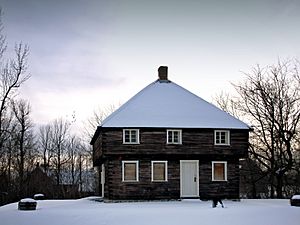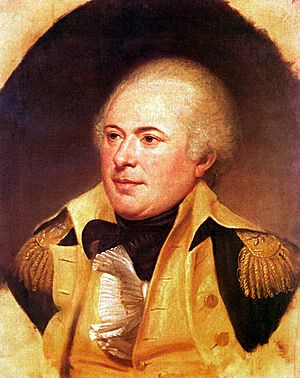Battle of Lacolle Mills (1814) facts for kids
Quick facts for kids Battle of Lacolle Mill |
|||||||
|---|---|---|---|---|---|---|---|
| Part of the War of 1812 | |||||||
 Lacolle Mills Blockhouse |
|||||||
|
|||||||
| Belligerents | |||||||
| Commanders and leaders | |||||||
| Strength | |||||||
| 500 | 4,000 | ||||||
| Casualties and losses | |||||||
| 11 killed 44 wounded 4 missing |
13 killed 128 wounded 13 missing |
||||||
The Battle of Lacolle Mills happened on March 30, 1814, during the War of 1812. It was a fight where a small British outpost, helped by more soldiers, successfully defended against a much larger American attack. This battle showed how tough the British and Canadian defenders were.
Contents
The Battle of Lacolle Mills: A Quick Look
The War of 1812 was a conflict between the United States and Great Britain. It also involved British North America (which later became Canada). This battle was one of the last major fights in the northern part of the war.
Why did the battle happen?
After a big battle called Crysler's Farm, the American army was defeated. Their leader, Major General James Wilkinson, moved his troops to French Mills, New York. This was just inside the United States border.
The American Army's Tough Winter
British leaders worried the Americans might attack their supply routes. These routes ran along the St. Lawrence River. However, Wilkinson's army had many problems. They had very few supplies. Bad roads and a lack of wagons made it hard to get food and equipment. Many soldiers became sick. Hospitals were full, and conditions were very poor.
In January, the Secretary of War, John Armstrong, told Wilkinson to move his army. About 2,000 men went to Sackett's Harbor. The main group of 4,000 soldiers moved to Plattsburgh, New York. The sick soldiers were sent to Burlington, Vermont. British troops followed them, taking back supplies. They also helped many sick American soldiers.
Britain's Small Fort
Wilkinson wanted to improve his reputation after his earlier defeat. He planned several attacks. One target seemed possible: a British outpost a few miles north of the border. This outpost was at the Lacolle River. It had a strong stone watermill and a Lacolle Mills Blockhouse. About 80 British soldiers from the 13th Regiment of Foot defended it. They also had a special group of Royal Marine Artillery with Congreve rockets. These rockets were new and scary weapons at the time.
The Battle Begins
On March 27, 1814, Wilkinson marched his 4,000 men from Plattsburgh. They had 11 cannons. Their march was slow because of deep snow and mud. They finally reached Odelltown on March 30. The attack on Lacolle Mill started in the early afternoon.
American Attack and British Defense
The Americans began firing with two large cannons and a mortar. They tried to use an even bigger cannon, but the ground was too soft. The British defenders fired back with their Congreve rockets. These rockets were not very accurate. But they scared the American soldiers, who had never seen them before. The rockets also caused some injuries.
The British soldiers from the 13th Regiment of Foot were nearby. They bravely charged the American cannons with bayonets. But there were too many American soldiers, and the British had to fall back.
Reinforcements Arrive
Other British and Canadian soldiers heard the fighting. A company of Canadian Voltigeurs and the Grenadier company of the Canadian Regiment of Fencible Infantry quickly marched to help. They waded through icy water to get past the American lines. Then, they opened fire on the American artillery. They wounded the American artillery commander and many of his crew. British gunboats also joined the fight. Commander Daniel Pring of the Royal Navy brought his ships up the Richelieu River. They fired on the Americans from the water.
By evening, the Americans had not made much progress. Wilkinson decided to retreat instead of launching a full attack. The American soldiers returned to Plattsburgh, feeling very discouraged. Wilkinson himself was very brave during the battle. He exposed himself to enemy fire, but it didn't change the outcome.
What happened after the battle?
General Wilkinson's Next Steps
On April 11, Wilkinson received orders to step down from his command. This was not just because of the Lacolle Mills battle. Wilkinson had already asked for an investigation into his actions during the St. Lawrence campaign. He later faced a court martial. However, he was found not guilty of the charges against him.

His removal allowed other, younger officers to take on bigger roles. Major General George Izard took command at Plattsburgh.
Remembering the Regiments
Many modern units in the United States Army remember the American regiments that fought at Lacolle Mills. These include several infantry battalions.
In the British Army, the Rifles Regiment continues the history of the 13th Regiment of Foot. In the Canadian Army, the Royal 22e Regiment remembers the Canadian Regiment of Fencible Infantry. Les Voltigeurs de Quebec remember the Canadian Voltigeurs. Even though there wasn't a special award for this battle, both Canadian regiments have the honor "Defence of Canada, 1812-1815." This honor is for Canadian units that fought well in the War of 1812.
The place where the battle happened was named a National Historic Site of Canada in 1923.



